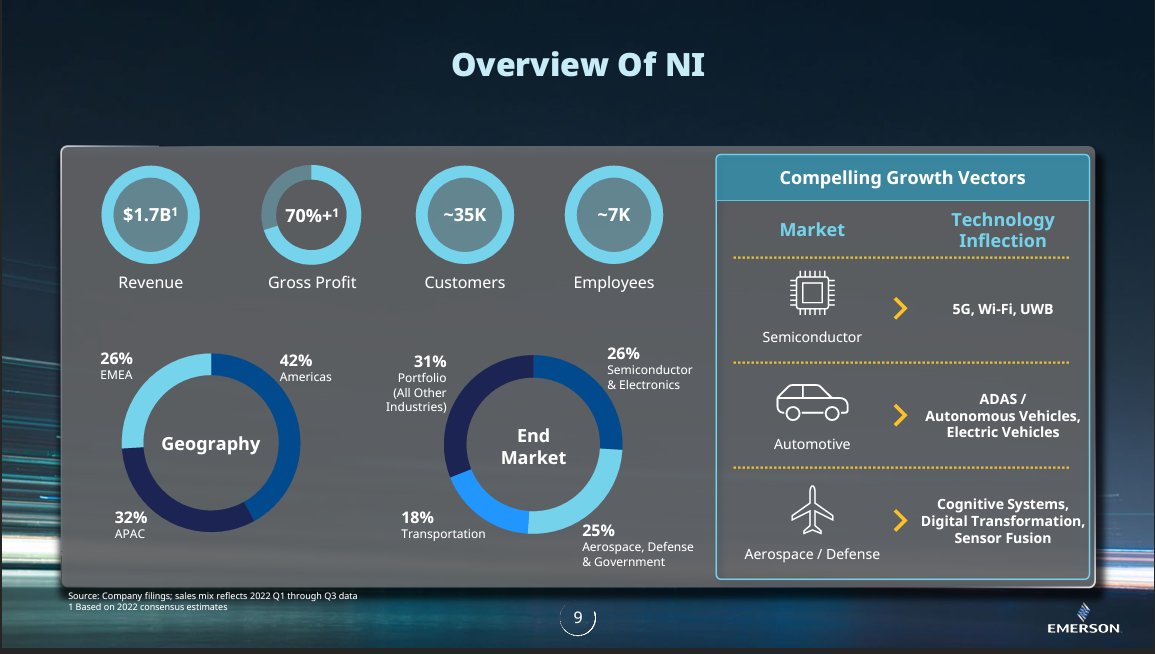The term "hostile takeover" begets images of "raiders" dawning two-toned collared shirt & suspender combos, screaming into phones in a cigar-smoke-clouded mahogany rooms filled with dot matrix printer tear-sheets...
But, $EMR showed that companies too can also "go hostile"🧵
But, $EMR showed that companies too can also "go hostile"🧵
So yesterday, $EMR announced *a proposal* to acquire $NATI for $53.00 a share (~$7.6bn and 32% premium to last close)
$NATI is a $1.7bn electronic T&M business with 70% GMS, 35K customers across diverse end markets
Deal would advance $EMR's global automation focus & strategy



$NATI is a $1.7bn electronic T&M business with 70% GMS, 35K customers across diverse end markets
Deal would advance $EMR's global automation focus & strategy




Why go "hostile"?
Well, in short, if as a buyer you're getting stonewalled by management & their Board, you can put the target "in play" by going directly to shareholders
$EMR made many attempts to engage with $NATI in private dating to 5/22 with no constructive engagement
Well, in short, if as a buyer you're getting stonewalled by management & their Board, you can put the target "in play" by going directly to shareholders
$EMR made many attempts to engage with $NATI in private dating to 5/22 with no constructive engagement
$EMR does a good job cataloging their history of interactions with $NATI
"Hostile" actions are always carefully planned
With 2023 "proxy season" looming, my sense is that "going hostile" was in the cards in the event of no substantive path to a deal following the 11/3 offer
"Hostile" actions are always carefully planned
With 2023 "proxy season" looming, my sense is that "going hostile" was in the cards in the event of no substantive path to a deal following the 11/3 offer

$EMR's PR playbook is textbook, unveiling:
1⃣ Website "maximizingvalueatni.com"
2⃣ PR (w/ email correspondence)
3⃣ Investor presentation & call
All painting a narrative of delay tactics by $NATI voiding shareholders the opportunity to participate in the deal's value creation



1⃣ Website "maximizingvalueatni.com"
2⃣ PR (w/ email correspondence)
3⃣ Investor presentation & call
All painting a narrative of delay tactics by $NATI voiding shareholders the opportunity to participate in the deal's value creation




Several tactics a buyer can utilize in order to effect a "hostile takeover" include:
1⃣ Proxy contest
(i.e. shareholders "vote by proxy")
2⃣ Tender offer
(i.e. shareholders "vote with their wallets")
3⃣ Open market purchases
$EMR is going with Door #1: Proxy context
1⃣ Proxy contest
(i.e. shareholders "vote by proxy")
2⃣ Tender offer
(i.e. shareholders "vote with their wallets")
3⃣ Open market purchases
$EMR is going with Door #1: Proxy context
How do targets play "defense"? There are 2 buckets:
"Generate More Votes"
1⃣ Dual-class structure (i.e. high & low votes)
2⃣ ESOP plan
"Become Less Attractive"
3⃣ Divest a "crown jewel"
4⃣ Shareholder rights plan (i.e. "poison pill")
5⃣ Golden parachutes
On 1/13 $NATI did #4
"Generate More Votes"
1⃣ Dual-class structure (i.e. high & low votes)
2⃣ ESOP plan
"Become Less Attractive"
3⃣ Divest a "crown jewel"
4⃣ Shareholder rights plan (i.e. "poison pill")
5⃣ Golden parachutes
On 1/13 $NATI did #4
TLDR on $NATI's "flip-in" "poison💊"
"If anyone (e.g. a hostile buyer) acquires 10%+ of $NATI's stock, other shareholders can purchase newly issued $NATI stock at a 50% discount"
Intent (via dilution) is to make an accumulation of a control stake economically "self-defeating"
"If anyone (e.g. a hostile buyer) acquires 10%+ of $NATI's stock, other shareholders can purchase newly issued $NATI stock at a 50% discount"
Intent (via dilution) is to make an accumulation of a control stake economically "self-defeating"
My thoughts...
Not $EMR's 1st rodeo (hostile on $ROK in '17) & they can sign a deal by $NATI's earnings (1/31)
$NATI's "reactive guide pump" (below) & poison💊denote standalone path conviction but the strategic review signals appetite to get to *a* deal beyond fiduciary CYA


Not $EMR's 1st rodeo (hostile on $ROK in '17) & they can sign a deal by $NATI's earnings (1/31)
$NATI's "reactive guide pump" (below) & poison💊denote standalone path conviction but the strategic review signals appetite to get to *a* deal beyond fiduciary CYA



Thanks to @NonGaap for the topic suggestion
Follow me at @GlogauGordon & you enjoy some steam of consciousness on #mergersandacquisitions, #SaaS and other topics (perhaps even a Substack someday)
RT, like, spread the word🙏
Follow me at @GlogauGordon & you enjoy some steam of consciousness on #mergersandacquisitions, #SaaS and other topics (perhaps even a Substack someday)
RT, like, spread the word🙏
• • •
Missing some Tweet in this thread? You can try to
force a refresh
















